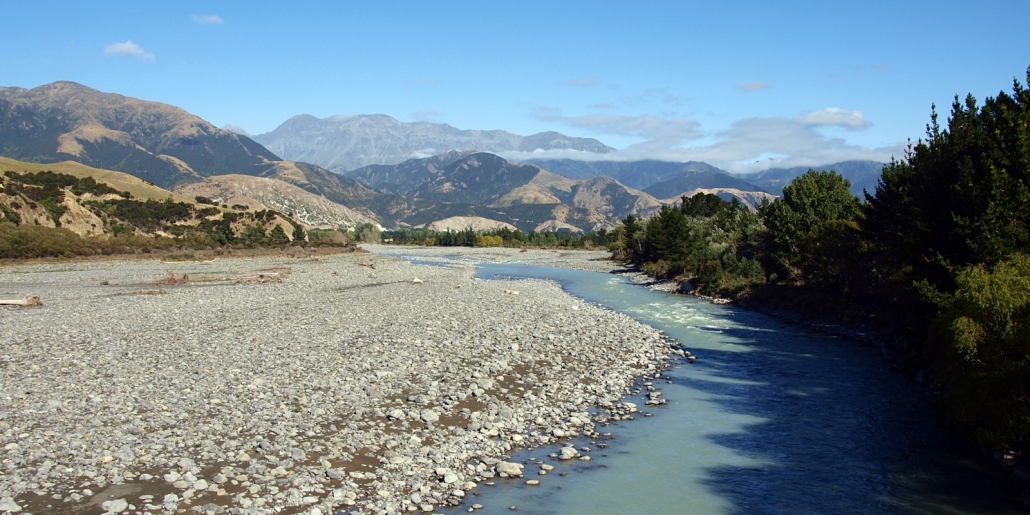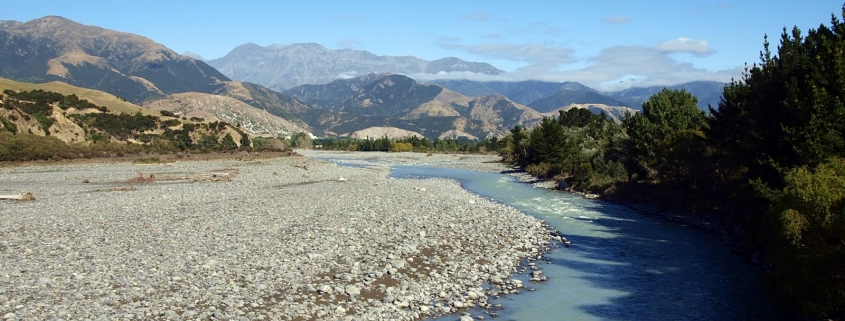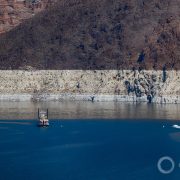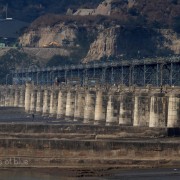New Zealand Waterways Fouled by Farm Runoff, Tourist Waste
Pesticides, trash, and heavy metals litter New Zealand’s waterways.

Clarence River, New Zealand. Photo courtesy of Wikimedia Commons.
By Kayla Ritter, Circle of Blue
New Zealand has long prided itself on a lush countryside and magnificent waterways. The tourism industry profits from the association, marketing the country as ‘100% Pure.’
The reality, though, is far murkier.
A new report from the Environment Ministry and Stats NZ compiles recent scientific research on the country’s environmental health. The report describes in detail the degradation in the last two decades of natural assets.
Pesticides, trash, and heavy metals litter New Zealand’s waterways. Destruction of 90 percent of the country’s native wetlands, a process that took centuries and still continues, and felling trees also damaged water quality. Perhaps the biggest influence on water pollution, though, is the rapid growth in the last two decades of the dairy industry.
“This report provides a health check on our environment and shows it’s under pressure in many places – in our towns and cities, and rivers and oceans,” Vicky Robertson, the environment secretary, said in a statement.“If we want to protect the things we value, now and for future generations, we need to focus our attention on the choices we make from here on.”
What’s Causing the Pollution?
New Zealand’s dairy industry has boomed recently, with the number of dairy cattle growing 70 percent since 1994, to 6.5 million head. Many experts blame its growth for the decline in water quality.
Dairy industry contamination is two-fold. Cows produce more nitrogen than sheep, which had been the dominant livestock industry. At the same time, farmers are using more fertilizer to cultivate the best fields for their herds and packing more animals onto each parcel of land. The combined effect is streams that are overloaded with nutrients. Excess nutrients can cause toxic algal blooms and low oxygen levels that are harmful to fish and amphibians.
A report by the National Institute of Water and Atmospheric Science declared that the pastoral boom is responsible for much of New Zealand’s poor water quality, noting that the worst contamination is found in regions with the most dairy farming. River stretches in farming regions have 10 times as much total nitrogen as those flowing through undisturbed land. In some places, the pollution can get so bad that residents are discouraged from even touching the water.
Bacterial risks are also present. E. coli levels in rivers in farming regions are 14 times as high as those in undisturbed lands. A 2016 outbreak of gastroenteritis on the North Island was linked to sheep feces in the water supply. The outbreak killed four people and sickened 5,000.
New Zealand’s waterways face more threats that just pastoral farming, however. Earlier this year, DairyNZ CEO Tim Mackle argued that dairy farmers have taken precautions against water contamination by fencing off 97 percent of waterways on dairy farms and maintaining a safe distance from wetlands. Mackle acknowledged the potential for farming pollution, but called for a more nuanced exploration of New Zealand’s water contamination
“The reality is that all types of land use contribute to water quality – and that farming, whether it’s vegetables, fruit, beef, sheep, dairy, deer or even wine – must all work together to make sure waterways are protected,” Mackle declared. “The most polluted rivers actually run through urban centers, and this is where the public can do their bit too.”
Human waste is certainly a component in the water pollution equation. Heavy metals, likely from industrial waste, have been detected in waterways. Tourism has taken its toll, too. Freedom campers, who tent or park in areas not designated for camping and often have no waste disposal facilities, are becoming a nuisance.
A 2014 report by the Environment Ministry determined that 60 percent of lakes and rivers are too polluted for swimming. A more recent estimate claims that two-thirds of all rivers and three-quarters of lakes are unswimmable.
As concern about degraded rivers and lakes grows, the government has pledged to crack down on pollution. Prime Minister Jacinda Ardern promised environmental reforms during her 2017 campaign. Government officials pledged to make 80 percent of the country’s rivers and lakes swimmable by 2030, and 90 percent by 2040.
Progress so far has been difficult to determine.
“It still seems to me that water quality is not improving,” Professor Russell Death, an ecologist, noted at a February conference of the New Zealand Freshwater Science Society. “If it is, it’s only very, very slowly improving. To my mind, there’s no convincing evidence that we’ve turned around the decline that’s been going on over the last 20 years.”
Analysts say that water quality will likely be a key issue in the country’s 2020 general elections, where Ardern will be up for reelection.
Negative Swing in Public Sentiment
The campaign staff will want to pay attention to the polls. Many residents are alarmed at the environmental trends.
A survey conducted in December 2018 found that New Zealanders are more worried about clean water than any other issue. The survey was commissioned by the non-governmental Fish & Game New Zealand and reported that lake and river pollution is a key concern for 82 percent of New Zealanders. Respondents ranked water contamination ahead of topics such as the cost of living, healthcare, and child poverty.
Another survey, released this month by Singapore-based ValueChampion, found that New Zealand falls short on several environmental markers. The study ranked 13 Asian-Pacific countries on a variety of categories, including pollution, greenhouse gas emissions, and waste. New Zealand ranked first in air quality and green space, but fifth for water quality and twelfth for plastic pollution.
“Kiwis are extremely worried that they are losing their ability to swim, fish and gather food from their rivers, lakes and streams,” said Martin Taylor, the chief executive of Fish & Game New Zealand. “People see those activities as their birthright.”
Kayla Ritter is a recent graduate of Michigan State University, where she studied International Relations and Teaching English to Speakers of Other Languages. She is currently based in Manton, Michigan. Kayla enjoys running, writing, and traveling. Contact Kayla Ritter












Focusing our attention on the choices we make is good advice indeed. If everyone was able to make a small contribution on a daily basis by becoming aware of the impact of their choices, we could all be well on our way to a sustainable future with clean water.
respected sir i have read about the pollution caused by agricultural waste that is causing the rivers of southern island and there by causing theflora and fauna to lose there charm and the tourism industry in NZ to lose its status as a tourist destination . The rivers that were crystal clear has now got a stench and the fish life has taken a beating . the fresh water that once flowed to the sea has now sent a stench and dead materials floating . i would like to help NZ with reclaming its status as a number one spot in the tourism map if you give me a chance to prove my idea i can present my ideas to help the country move forward. I am eagerly awaiting your reply.
thanking you,
yours truly,
VIVEK